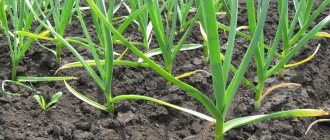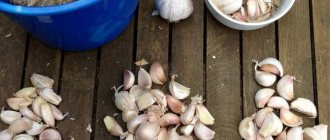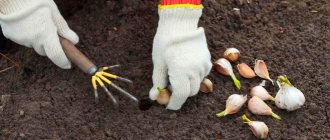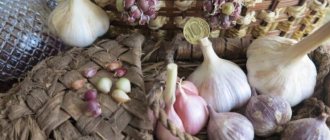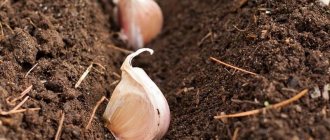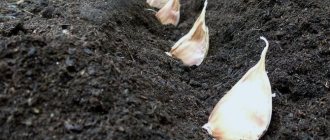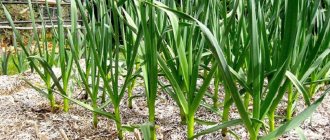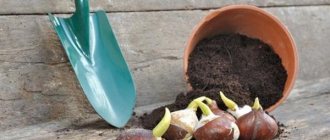Why is planting garlic for the winter so popular?
Planting garlic for the winter is a fairly popular agrotechnical trick, which has many advantages compared to planting seed in the spring. Firstly, it is almost impossible to miss planting time in the fall. It is enough to focus on weather reports in your region. But there are other more significant advantages:
- Winter garlic stores well.
- The vegetable is resistant to adverse weather conditions.
- The soil prepared over the summer contains all the necessary useful components that help to obtain a high-quality harvest.
- Overwintered garlic practically does not get sick during the growing season and does not attract pests.
- The harvest ripens early, so you can use the vegetable for food in early spring.
Planting garlic for the winter
The garlic crop that has overwintered is also different in size compared to the spring variety, which is planted in the spring. The heads are larger and the teeth are regularly shaped.
Why do you need to cover the beds?
Many gardeners are familiar with the technique of planting garlic “in winter”, because this method has significant advantages:
- planting material undergoes excellent hardening, which means it is resistant to diseases;
- winter garlic produces vigorous shoots;
- plants are not afraid of drought at the growth stage;
- this garlic stores well;
- saves the gardener valuable time in the spring.
Garlic planted in winter must be covered. This is done primarily to protect young plants from frost. Without shelter, the number of surviving plants is significantly reduced and they are much weaker.
Other benefits of covering garlic:
- plants survive temperature changes, because winter thaws can encourage garlic to grow;
- the future garlic harvest increases;
- sprouts are protected from certain diseases and pests;
- prevents excessive soil moisture when snow melts, and therefore rotting;
- harvest 1-2 weeks earlier;
- The gardener’s valuable time is saved in the spring, since the shoots will be friendly and strong.
How to plant garlic? Read here.
Do garlic need shelter in winter?
In the process of preparing for winter, a lot of questions arise regarding whether it is necessary to cover garlic planted before winter. This method of agricultural technology is used by many gardeners to improve the quality of the crop and its rapid ripening. Therefore, covering the crop before the onset of cold weather is simply necessary.
Garlic harvest under cover
Why do you need to cover the beds?
To determine exactly why to cover garlic for the winter, it is worth studying the results of agrotechnical cultivation, which will accurately indicate the advantages of such protection. Proper shelter of winter garlic after planting is necessary in order to protect the crop from adverse factors:
- Covering helps protect plantings from freezing and icing during short-term thaws.
- The auxiliary layer guarantees the maintenance of normal soil moisture if there is no snow or rain during the winter.
- When the snow begins to melt, the top layer of protective material absorbs excess moisture, which means that the planting will definitely not become waterlogged.
- As a result of sudden changes in weather conditions, the formation of arrowheads may occur in the early stages of development. If the bed is covered, the crop will be protected from this.
- If there is no auxiliary cover, then there is open access for the development and active growth of weeds, which can negatively affect the quality and quantity of the crop.
Garlic grown under cover
The correct choice of material for forming a protective layer can also have a positive effect on the fertility of the land, which will improve the chances of getting a good harvest.
Why do this?
Mulching beds with winter garlic helps preserve crops and improve the characteristics of the future harvest. Properly sheltered plants produce early shoots. A layer of mulch protects not only from winter frosts, but also from sudden changes in weather: during unexpected warming, which gives way to heavy snowfalls and serious frosts, the crops grown do not freeze out.
The use of new generation covering materials makes it possible to create a favorable microclimate for cultivating various garden crops, and also prevents overcooling of the soil. The formation of glaciation in the soil can cause the death of plants. To protect garlic planted in open ground for the winter, it is recommended to cover the beds. In addition, the amount of weed grass growing in the spring between sowings decreases.
Tags: winter, winter crops, cover, garlic
About the author: admin4ik
« Previous entry
When to cover: time, timing, temperature
In order for the bed to be protected, but at the same time the covering does not cause the garlic to sprout before winter, you need to accurately determine the need for the formation of a protective layer. Every gardener should know the characteristics of his region and adhere to the following recommendations:
- In the Central regions, the procedure can be carried out from the end of September to the first days of November.
- In the southern regions - from early October to early November.
- In the Northern regions - from early September to early October.
Additional Information! In the Northern regions, it is possible to form a shelter immediately after planting the crop. This is necessary due to difficult natural conditions.
Other factors will influence the timing:
- winter garlic needs to be covered before the first snow falls;
- if the temperature drops below +10 °C;
- if strong winds begin.
Time for shelter
If you follow the weather forecast and strictly follow the planting schedule, then you will definitely not be able to make a mistake with the time of formation of the shelter for the crop.
When to plant winter garlic
In central Russia, it is customary to plant the crop in mid-September. Later, plant seeds may already die at the first drop in temperature. But do not rush and plant garlic before this time, as it will begin to grow. In such a situation, the crop will no longer tolerate the cold and will have to be replanted in the spring.
When planting garlic in October, it is recommended to soak the cloves for several hours in a humate solution or simply in warm water. Then you need to moisten the sawdust with this water and sprinkle the cloves. After a few days, roots will appear. In mid-autumn, such garlic can be planted in the ground. If the ground begins to freeze, it should be watered with warm water.
Moon calendar
It is recommended to harvest on the most favorable days according to the lunar calendar. To determine them, the table below is useful.
| Favorable days in July | Favorable days in August |
| 6-8, 12-14, 30-31 | 2-5, 19-20, 24-25 |
If the crop does not ripen, it will retain too much moisture. Because of this, the fruits will soon begin to rot and they will not be stored for a long time.
Attention! You need to take into account the lunar calendar, but you should not forget about the weather conditions on the selected day. The weather should be dry to prevent the fruit from getting wet, which can lead to further rotting.
Where is garlic covered, in which regions, and where is it not covered?
When looking for a solution to the question of whether it is necessary to cover garlic when planting before winter in certain regions of the country, you need to know that covering provides mulching. This property increases the protective properties of the crop, nourishes the soil with useful substances and maintains normal moisture levels.
Garlic shoots in the garden
Therefore, using this method of cultivating garlic in winter is simply necessary in any region. But in each area, additional purposes for using the cover are pursued:
- In the North - protection from frost.
- In the South - ensuring a normal level of humidity and protecting against soil weathering.
- Middle zone - improvement of soil fertility and protection from icing after thaws.
Note! In the Southern regions, it is not necessary to cover the garlic if the garlic will be constantly cared for.
Regardless of the region, it is better to take care of the culture so that you do not have to rely on the forbearance of nature.
Preparing beds and planting material
Preparing the landing site is also important. Any actions are carried out two weeks before the expected date of planting garlic.
This may include the following actions:
- cleared of debris and weeds;
- dig up carefully;
- saturate the earth with nutrients;
- When forming grooves, ash is added, and sand is poured onto the bottom.
Read in more detail how to prepare a bed for planting garlic before winter.
It is recommended to place the cloves in warm water for a while immediately before planting. In addition, it is recommended to temporarily immerse them in a special solution to accelerate the formation of roots.
How to cover: materials for covering
In the process of preparing for wintering, it is sometimes difficult to decide what to cover the garlic with for the winter. There is a huge variety of options that can be used in everyday life. Some require additional costs, others are made from scrap materials. The ideal option for garlic with the most positive characteristics is indicated below.
Plant stems
Plant stems or spruce branches can provide adequate protection in winter. The advantages of this type of insulation can be:
- complete protection from frost;
- protect from waterlogging;
- do not allow snow to fall on the sprouts.
Plant stems as shelter
If you cover the bed with such material, you should be wary of the following:
- the stems may become denser, which will reduce air permeability for the rest of the period;
- over time, the base begins to rot, which increases the temperature of the soil under the layer;
- Mold may form or rotting may begin.
When preparing the stems, you need to remove all seeds from them and inspect them for pests.
Application of peat
Peat is an ideal shelter in regions where severe frosts may occur. Natural material retains heat remarkably well. Additionally, peat retains the required moisture well and performs the function of mulching.
Peat may be the best shelter option
This insulation has some disadvantages. Increased acidity of peat can negatively affect the plant during the growing season. If there are constant thaws in winter, the material may become compressed, which means it will lose its heat-insulating properties and form an almost airtight crust.
Fallen leaves
Often fallen leaves from birch, maple or oak are used for insulation purposes. This base has good breathability and retains heat well. And most importantly, the material is available in unlimited quantities.
Mulching with leaves
But if you fill the bed with leaves, you should also be aware of some troubles that can happen during the wintering period:
- Freezing is possible due to sudden temperature changes with possible thaws.
- Foliage can accumulate a lot of moisture over time and rot, gradually transferring this process to the sprouts.
- Pests can grow in the foliage and spend the winter next to the plant, causing harm to it.
Covering materials
The best materials are considered to be organic. They must be laid out on beds at least 8-10 cm thick. The maximum thickness can reach 20 cm.
A significant increase in thickness is permissible only in rare cases. A layer that is too thick can have a negative impact on the crop.
The following materials can be used:
- Foliage, needles, various plant debris. This is the most accessible and cheapest material. Organic matter will protect against low temperatures, improve the composition of the soil and nourish it with useful microelements.
- Peat, manure or rotted compost. It is worth considering that manure is only suitable for very poor soils. Garlic does not require the high level of nitrogen that this type of fertilizer provides. In addition, it is advisable to use manure only after the soil has frozen and the top layer of soil has covered with ice. Otherwise, the garlic cloves are at risk of burning. In turn, peat is not recommended for the northern regions, since under its influence the timing of crop germination noticeably shifts. It also contributes to soil oxidation. And in the spring it can turn into a crust over the ground, which can be difficult to remove.
- Sawdust, hay and straw. Only large sawdust is suitable for garlic. Tyrsa absorbs too much moisture and it will be problematic to remove it in the spring. Mulching with straw has certain disadvantages: it retains too much moisture, so in regions where there is a large amount of melt water and periodic frosts, the death of the plant due to freezing or rotting is guaranteed.
- Green siderates. A good choice for any region. After digging up green manure with soil, you can get an excellent fertilizer that will saturate the soil with a large amount of useful substances.
- Agrofibre. This is what is commonly called non-woven material. This includes spunbond and lutrasil. They are increasingly used to protect garlic beds, as they have good thermal insulation properties. The most common use of such material is in the northern regions. Sometimes they make a multi-layer coating there to protect the seeds from freezing and drying out.
Agrofibre looks like a thin film. The main advantage is reusable use. It may last for 5-6 seasons if handled with care. For shelter, it is enough to lay it over the garden bed and secure it along the edges, for example, with stones. Excess moisture does not accumulate under it, and the sun's rays pass through the material perfectly. Plantings under such a covering will never freeze. In spring, the covering can act as a greenhouse. But it’s worth considering that using agrofibre is only permissible in southern cities. In the middle zone and in the north of the country it is worth thinking about additional cover, for example, with organic matter.
How to properly cover garlic
Multi-layer crop cover should be performed in the presented sequence:
- First, you need to level the area after planting the garlic cloves and sprinkling them with soil.
- Mulch with organic matter. The layer should be approximately 5-6 cm. This will be quite enough.
- Lay out the second layer of agrofibre. It can be replaced with spruce branches.
- After the first snow appears, it is recommended to insulate the beds by covering them with snowdrifts.
How to choose green manure
Garlic will grow better in light soils. To improve the quality of the soil, green manure should first be planted, which includes:
- cereals with the exception of rye;
- legumes;
- white mustard;
- forage grasses.
Garlic should not be planted after plants that have a similar root system. The break must be at least two years.
Tips and tricks
Before you decide exactly how to protect garlic from frost for the winter, you need to take into account some recommendations. This will allow you to make more informed choices.
- The covering layer of any type of material should not exceed 7 cm in thickness. Excessive pressure and an excess of negative influence, which cannot be avoided in any case, can cause irreparable harm to the plant.
- There is no need to rush to cover a planted bed if there is no direct indication to do so. During the period while the soil is open, it “stores” oxygen and helps the plant harden.
- To avoid the appearance of pests in the covering material, onion peels are mixed in, which repels “uninvited guests” with its smell. This is a very effective harvest preservation technology.
- It is necessary to take into account the primary acidity of the soil. If it has a high level of acid content, then you should not use peat or sawdust as a covering. This raw material will increase this indicator, which is undesirable for this crop.
- The type of protective material is selected according to the region. In the southern parts of the country, there is no need to use insulation options that are too heat-retaining, but in the northern parts it is worth choosing the base carefully.
Other nuances may appear in the process of creating a protective layer. Therefore, you need to plan everything carefully.
Garlic in spring
Growing good garlic can be achieved through care and proper care. It is especially important to maintain normal conditions during the winter season. To protect the crop from freezing, rotting and waterlogging during the cold season, you need to make a special cover for the garden bed. You can use different materials in this capacity. But when choosing, you should take into account all the positive and negative properties of each option.
Mulching trees and shrubs
Currants develop well and bear fruit abundantly on drained soils with a properly adjusted air-water regime. The plant is demanding regarding temperature and soil moisture levels. Does not tolerate proximity to weeds, which create a favorable environment for the proliferation of pests and the development of diseases of berry bushes.
Mulching the soil with sawdust makes it possible to solve these problems and create the necessary conditions for growth and fruiting, therefore it is the most important agrotechnical technique when growing berry bushes. In addition, the use of a protective layer allows you to almost double the berry yield.
Obtaining high raspberry yields is impossible without adding a protective substrate, which helps retain soil moisture, which is extremely necessary during the period of berry set. Without such protection, the yield of berry bushes drops by half. Cover the plantings with a thick layer of shavings (at least 8-10 cm), having previously applied complex fertilizers. Mulching raspberries with sawdust helps solve several problems at the same time:
- protect the root system from freezing or drought;
- protect the soil from weathering;
- improve the structure and aeration of the soil in the raspberry field;
- create a comfortable temperature regime for the root system;
- increase the period of operation of the raspberry plant;
- retain moisture in the soil to reduce the number of waterings;
- protect raspberries from diseases and pests;
- feed the subshrub;
- inhibit the growth of weeds.
Mulching with fresh sawdust is the most common way to protect raspberries. Thanks to it, raspberry bushes do not degenerate and bear fruit well without replanting for up to 15 years. The best time to apply a protective cover is spring. Before starting work, you should feed the raspberry tree with nitrogen fertilizers, since unrotted sawdust removes nitrogen from the soil.
There is no need to be afraid of soil acidification - raspberries tolerate slightly acidified soils well. It is only undesirable to mulch raspberries with this material before winter. Sawdust absorbs moisture during winter thaws, and during spring frosts it turns into an ice shell, which will not allow the soil to warm up in time and will delay the development of raspberry bushes.
Early flowering of cherries often leads to loss of harvest, since the flowers and ovary are in danger of freezing during numerous frosts. To avoid danger, experienced gardeners cover the ground under the crown with a thick layer of snow and lay small shavings on top. The light color does not attract sunlight, and the low thermal conductivity of sawdust prevents the snow from melting quickly. This technique allows you to delay flowering until the threat of frost disappears and preserve the harvest.
To cover the trunk circles of trees and shrubs, you can use large sawdust, which is laid in a high layer. The use of shavings as a covering material not only benefits woody plants, but also gives the plantings a well-groomed aesthetic appearance.
What can be mulched with sawdust
If you follow a number of rules, wood waste is suitable for mulching any garden crops. For example, large sawdust is not suitable for vegetable beds due to a long period of decay, but serves as reliable protection for trees and shrubs. Completely rotted shavings will only bring benefits, saturating the soil with nutrients and improving its aeration.
In the open ground
There is a misconception that mulching strawberries with fresh sawdust can harm the plant. Unrotted small shavings take nitrogen from the soil only if they are mixed with the ground. Lying on the surface, it cannot harm the soil. Therefore, unrotted shavings are used to protect berry fields and are considered the most suitable mulch for strawberries. If small shavings are still mixed with the soil, you can correct the situation by periodically adding additional portions of nitrogen-containing fertilizers to the surface of the bed.
This protection helps:
- Maintain the balance of moisture in the soil necessary for setting and growing berries, while protecting the above-ground part of the plant from excess moisture.
- Protect strawberries from invasion of slugs and snails.
- Protect berries from the development of bacterial rot, black, gray, white and root.
- Reduce the number of weedings.
- Fresh sawdust helps preserve the presentation. Without coming into contact with the ground, the berries remain dry and clean.
You need to mulch the berries with clean material (without building impurities). The layer is applied close to the stems, and not just between the rows. Thickness - at least 5 cm. You can mix crushed shavings with urea or pre-feed the plants with fertilizers containing nitrogen. When the strawberry seedlings take root and grow, you need to add shavings, increasing the cover layer by another 3-5 cm.
To protect the berry garden from freezing in winter, it is necessary to prepare the bushes. The optimal method of protection is to mulch strawberries with sawdust in the fall, since they retain heat better than other materials and protect plants from pests and dangerous microorganisms that do not take root well in such an environment.
Under the weight of snow, the covering material sags, so the layer of fine shavings should be at least 20 cm. In the same way, you can cover other berries, such as blueberries, for the winter. The method works well for garlic.
For some vegetable crops, such as tomatoes and potatoes, mulching with sawdust is a necessity. This agricultural technique is actively used after hilling potatoes and in the middle of the fruiting phase of tomatoes. During hot, dry periods, the temperature of the upper fertile layer of the earth, where the root system of nightshade plants lies, exceeds permissible values.
In such conditions, plants are depressed and cannot develop normally. In addition, after watering, under the influence of sunlight, the soil immediately becomes crusty and cracks, damaging the roots.
After hilling, the resulting bare furrows are covered with a substrate, which allows:
- retain moisture;
- create comfortable conditions for the root system;
- inhibit weed growth;
- protect vegetable crops from pests.
It is useful to mulch with sawdust such vegetable crops as eggplants, peppers and cucumbers. As protection for carrots, it is best to use small coniferous shavings, which are a good means of repelling carrot flies and other pests of sweet root crops.



